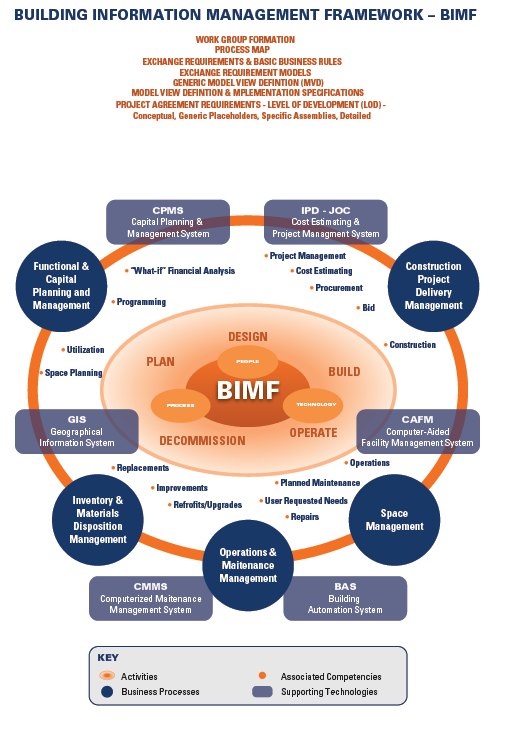The primary focus of the NBIMS-US™ is to provide open standards to transform the currently inefficient and ineffective life-cycle management of the built environment… Is this not the same value provided by BIM?
This transformation is accomplished through the creation and exchange of building information modeling (BIM) information and management processes. Elements included include reference standards; outlining classifications of data and processes, data exchange formats, requirements for many different types of information exchanges and practice standards; which outline practices and workflows for data modeling, project execution, and robust feedback on success or failures so that assumptions are quickly improved. The metrics by which these open standards are to be evaluated include: total cost of ownership vs. first costs, impacts upon organizational mission, sustainability, life-safety, utilization, up-time, project timelines, fewer change orders, fewer legal disputes, ….
Goals, Objectives, and Benefits of NBIMS and BIM:
- Reduce the total cost of ownership of the built environment in concert with the mission of an organization and its relationship to the environment via timely, accurate, re-usable information and associated enhanced decision support capability.
- Enable collaboration and information sharing among all shareholders via established products, methods, and information formats.
- Front end information gathering, planning, and decision-making to have the greatest positive impact in the overall design, procurement, construction, operations, and decommissioning process, taking advantage of collaborative, integrated project delivery.
- Information development and sharing via consensus documents that select a common path forward when multiple divergent paths were once available
- Build a growing community of practice which allows progress to be made built upon previous levels of agreement
- Share information with software vendors as well as other product and service providers to build solutions that supports a consensus agreement of practitioners
- Identify specific reference standards that are used for BIM
- Documents “best practices” to potentially become standard practice for creating and managing information be re-used and re-purposed
Building Owner Perspective
- How can I better optimizing building performance to contribute to improving overall performance (e.g. financial, environmental, organizational, operational efficiencies) across the lifespan of my physical assets.
- Where can I find process documentation and contract language to cost-effectively develop and consistently deploy efficient construction delivery methods, enable high quality and quantity work at a reasonable cost.
Contractor Perspective
- An understanding of how to develop long lasting relationships with Owners, AEs, Subs and leverage BIM and associated optimized construction delivery
- How to perform more projects that provide a more predictable revenue stream and a reasonable profit margin.
A/E Perspective
- Participation in emerging efficient project delivery processes to better acheive design excellence, meeting project schedules and exceeding client service expectations.
- An understanding of how to develop long lasting relationships with Owners, Contractors, BPMs …and leverage BIM and associated optimized construction delivery
- How to perform more projects that provide a more predictable revenue stream and a reasonable profit margin.
Business Product Manufacturer (BPM) Perspective
1. How can I make my products available to designers and contractors so that they fit in with BIM project delivery processes
2. How should I format my products as BIM objects (e.g. level of graphical detail and business properties) so they are most useful by designers and contractors
3. I am interested in getting designers and contractors to specify and purchase my product
ALL:
1. How to use BIM for specific construction tasks (e.g. cost estimating, material procurement, digital fabrication, valuation of in-place construction, commissioning and handover, safety management)
2. How to mitigate risk.
3. How to organize my organization and project teams to take advantage of BIM processes and technologies.
4. How to participate in emerging efficient project delivery processes to focus on design excellence, meeting project schedules and exceeding client service expectations.
5. I am interested in optimizing staff resources, project profitability, maintaining relationships with my clients and finding the next job
Ballot Cover Letter Statement:
The National BIM Standard is a consensus document, where many ideas are brought together, presented to a variety of people representing different parts of the industry, discussed, debated, and ultimately subjected to the democratic process to determine which ideas rise to the stature of inclusion.
Related docu,ment – http://fire.nist.gov/bfrlpubs/build04/PDF/b04022.pdf – Cost Analysis of Inadequate Interoperability in the U.S. Capital Facilities Industry Michael P. Gallaher, Alan C. O’Connor, John L. Dettbarn, Jr., and Linda T. Gilday



